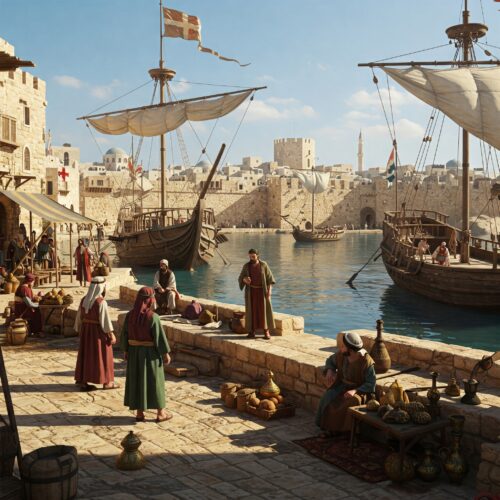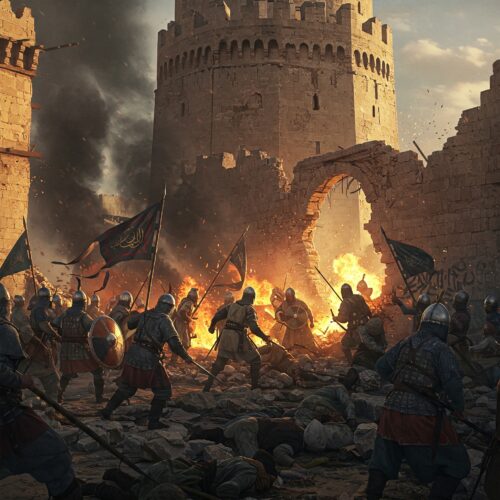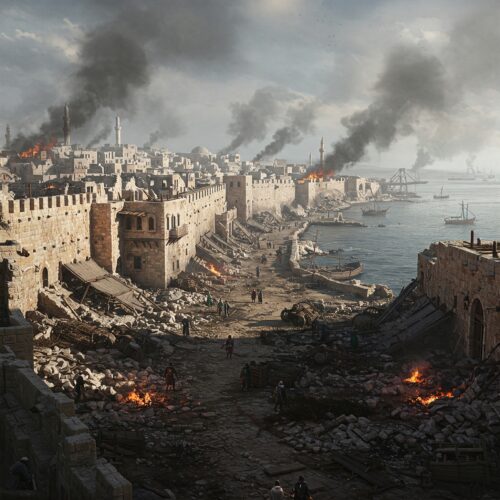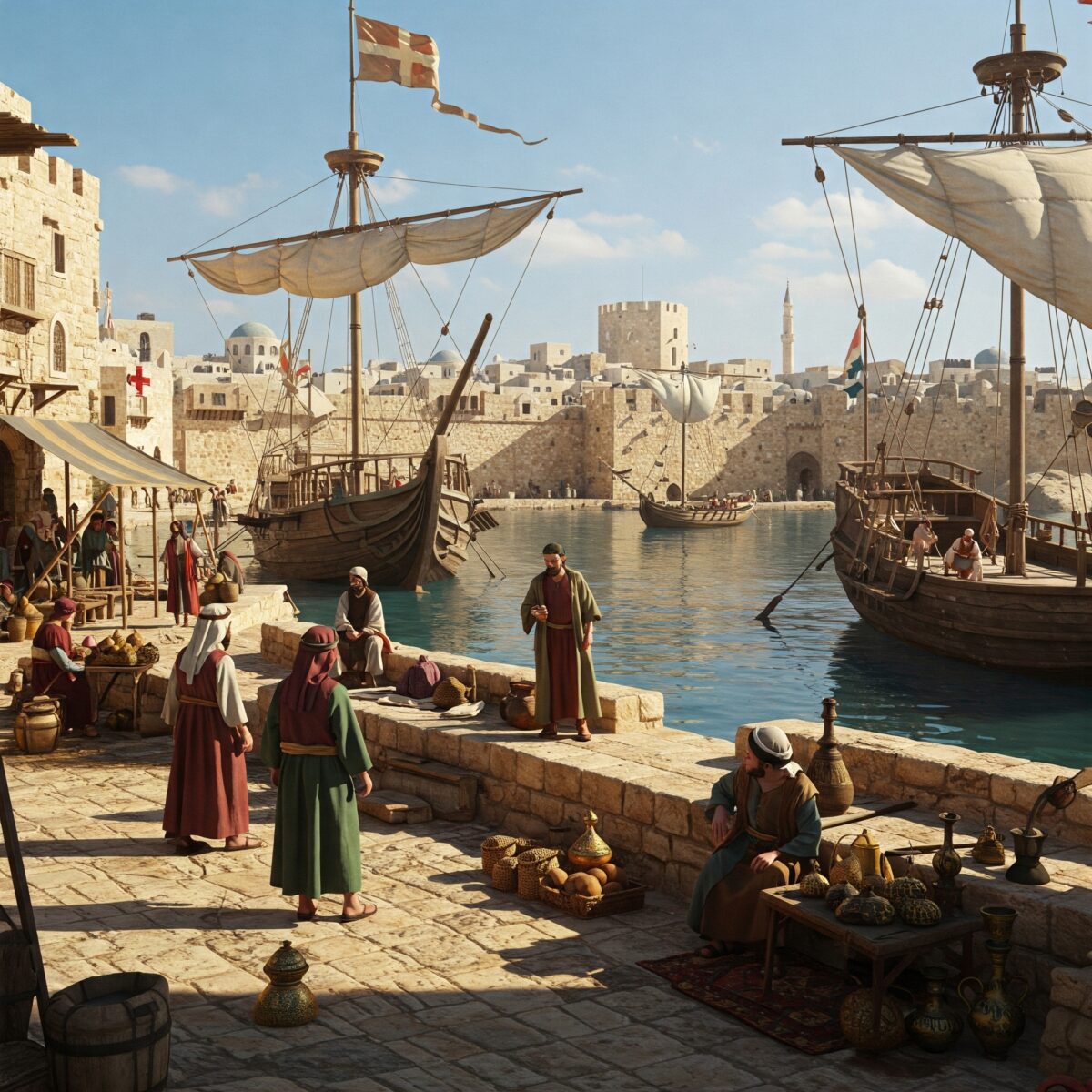History, often perceived as a dusty collection of dates and long-gone figures, possesses a remarkable ability to ripple through time, its currents subtly shaping our present and offering profound wisdom for our future. Today, May 18th, marks the anniversary of a truly momentous event from the distant past, one whose echoes, if we listen closely, can provide surprising insights into navigating the complexities of our own lives. On this day in 1291, the city of Acre, the last Crusader stronghold in the Holy Land, fell to the Mamluk Sultanate. This dramatic and brutal siege didn’t just redraw maps; it signaled the end of an era and offers us a powerful lens through which to examine themes of resilience, adaptation, and the often-painful necessity of letting go.
To truly grasp the significance of Acre’s fall, we must first journey back to a world starkly different from our own, a world where faith, honor, and territorial control fueled epic clashes of civilizations. For nearly two centuries, European knights, soldiers, and settlers, driven by religious fervor and the promise of land and glory, had established and defended a series of Crusader states along the Eastern Mediterranean coast. These kingdoms, including the Kingdom of Jerusalem, the Principality of Antioch, and the County of Tripoli, were precarious outposts of Latin Christendom in a predominantly Muslim region.
Acre, situated on the northern coast of modern-day Israel, was the glittering jewel of these states. By the late 13th century, it was more than just a fortress; it was a vibrant, cosmopolitan hub. Its strategic port teemed with ships from Venice, Genoa, Pisa, and other maritime powers, facilitating a lucrative trade in spices, silks, and other exotic goods flowing between East and West. Within its formidable walls, a diverse population coexisted – Knights Templar, Hospitallers, Teutonic Knights, alongside merchants, artisans, and pilgrims from across Europe. Different languages, cultures, and even rival Christian factions jostled for space and influence. Acre was, in essence, the operational capital of a fading dream.
The dream, however, was rapidly unraveling. The initial zeal of the early Crusades had waned, replaced by political infighting among the Crusader states and waning support from a Europe increasingly preoccupied with its own internal conflicts. More critically, the Muslim powers of the region, once fragmented and caught off guard, had consolidated their strength. The Mamluk Sultanate, based in Egypt, had emerged as a formidable military force, disciplined, well-equipped, and fiercely determined to expel the “Franks,” as the Crusaders were known.
Sultan al-Ashraf Khalil, the Mamluk ruler who orchestrated the final siege of Acre, was a man driven by this ambition. He had inherited a powerful war machine and a clear objective from his predecessors, most notably Baibars, who had systematically chipped away at Crusader territories. Khalil saw Acre as the ultimate prize, the final nail in the coffin of the Crusader presence.
The siege itself, which began on April 6, 1291, was a brutal and technologically advanced affair for its time. The Mamluks, numbering in the tens of thousands, perhaps even over a hundred thousand including auxiliaries, brought with them an arsenal of siege engines – massive trebuchets (called “mangonels” by the Crusaders) capable of hurling enormous stones to breach Acre’s legendary double walls, alongside smaller, more rapid-firing catapults. They also employed sappers, miners who dug tunnels beneath the city walls to collapse them from below.
Inside Acre, the defenders, though heavily outnumbered (estimates range from 15,000 to 40,000, including fighting men and armed citizens), were determined to resist. The city was heavily fortified, with a complex system of towers and ramparts. The military orders – the Templars, Hospitallers, and Teutonic Knights – formed the backbone of the defense, their renowned discipline and fighting prowess on full display. They were supported by troops sent by various European monarchs, including King Henry II of Cyprus (who was also titular King of Jerusalem), and contingents of Genoese and Pisan sailors.
The initial weeks of the siege were a relentless bombardment. Day and night, Mamluk siege engines pounded Acre’s defenses. The defenders fought back fiercely, launching counter-attacks and attempting to destroy the enemy artillery. Chroniclers from both sides paint a vivid picture of the ferocity of the fighting. Arrows rained down, siege towers were pushed towards the walls under a hail of missiles, and the air was filled with the constant din of war cries, clashing steel, and crumbling stone.
One of the most dramatic aspects of the siege was the Mamluk mining operations. Despite the defenders’ attempts to counter-mine and engage the Mamluk sappers in subterranean combat, the attackers succeeded in weakening key sections of the outer wall. The psychological impact of knowing the ground beneath your feet could erupt at any moment must have been immense.
As the siege wore on, the situation within Acre grew increasingly desperate. Food and supplies dwindled. Hopes of a major relief force from Europe, though fervently prayed for, failed to materialize in any significant strength. Internal divisions, never far from the surface in the Crusader states, also hampered a unified defense. Rivalries between the Venetian and Genoese merchant communities, and even between the military orders, sometimes complicated strategic decisions.
On May 15th, a major Mamluk assault breached the Accursed Tower, a key point in the outer defenses. Fierce fighting ensued, but the attackers managed to secure a foothold. This was a critical turning point. Three days later, on May 18th, after weeks of relentless pressure and with several major breaches in the walls, Sultan Khalil ordered the final, all-out assault.
The Mamluk forces poured into the city through the shattered defenses. What followed was a scene of horrific carnage. The defenders, fighting street by street, house by house, were overwhelmed. Contemporary accounts describe widespread slaughter of combatants and civilians alike. Many sought refuge in the heavily fortified compounds of the military orders. The Templar fortress, located on the southwestern tip of the city, became one of the last bastions of resistance. For days after the city’s main fall, the Templars held out, eventually negotiating a surrender that, tragically, was not fully honored, leading to further bloodshed.
The fall of Acre was swift and brutal. Thousands perished in the fighting and the subsequent sacking of the city. Those who were not killed were often enslaved. The Mamluks systematically dismantled Acre’s fortifications to prevent it from ever being used as a Crusader base again. Its magnificent churches were destroyed or converted into mosques, its bustling port silenced. The dream of a Latin East was over. The remaining Crusader outposts, such as Tyre and Sidon, fell soon after, their garrisons knowing that without Acre, their positions were untenable.
The immediate outcome was clear: the Mamluks had decisively and permanently ended the Crusader presence in the Levant. For Christendom, it was a devastating blow, prompting soul-searching and calls for new crusades that never truly materialized with the same force or focus as their predecessors. For the Mamluk Sultanate, it was a triumph, cementing their power and prestige in the Islamic world.
So, what can we, living in the 21st century, possibly glean from this distant, violent event? How can the fall of a medieval city nearly 734 years ago benefit an individual navigating the challenges of modern life? The connection lies not in the specific tactics of siege warfare or the religious ideologies of the Crusades, but in the universal human experiences embedded within this historical drama: the confrontation with overwhelming change, the pain of loss, the necessity of adaptation, and the surprising strength found in letting go.
- Recognizing Unwinnable Battles and the Courage to Retreat:
The defenders of Acre fought with incredible bravery and determination. They held out against a vastly superior force for six grueling weeks. Yet, in the end, the odds were insurmountably stacked against them. The broader geopolitical landscape had shifted. The Mamluks were ascendant, united, and possessed overwhelming military superiority. The support from Europe, critical for the Crusader states’ survival, had dwindled.
In our own lives, we often pour immense energy into situations, relationships, careers, or even personal beliefs that are, in reality, unwinnable battles. We might cling to a failing business out of pride, stay in a toxic relationship hoping it will change, or pursue a goal that is no longer aligned with our values or capabilities. The story of Acre reminds us that there is a point where relentless resistance ceases to be heroic and becomes self-destructive.
The “benefit” here is the wisdom to discern when a strategic retreat or a complete change of course is not a sign of failure, but a courageous act of self-preservation and a necessary step towards future growth. Just as the few survivors of Acre who managed to escape by sea had to abandon their homes and possessions, we too sometimes need to let go of what we’ve built or cherished to survive and eventually thrive elsewhere. This doesn’t diminish the effort or the bravery expended; it acknowledges a new reality. Applying this to your life could mean re-evaluating a career path that’s causing burnout, ending a relationship that is consistently damaging, or even letting go of an old dream that no longer serves you, freeing up energy for new, more viable opportunities.
- The Inevitability of Change and the Power of Adaptation:
The Crusader states, and Acre as their capital, represented a particular world order that, for two centuries, seemed entrenched. Yet, the fall of Acre starkly demonstrated that no earthly power or institution is permanent. Change is an inexorable force. The Mamluks themselves, who triumphed at Acre, would eventually be supplanted by the Ottomans.
We often resist change, fearing the unknown and mourning the loss of the familiar. We build our own “fortifications” – routines, comfort zones, rigid mindsets – hoping to keep the disruptive forces of life at bay. Acre’s fall teaches us that such defenses, no matter how strong they seem, can eventually be breached by the tides of change.
The benefit lies in cultivating adaptability and resilience. Instead of rigidly clinging to the “old walls,” we can learn to be more like water, flowing around obstacles and finding new paths. For the individual today, this means embracing lifelong learning to stay relevant in a rapidly evolving job market, being open to new perspectives and experiences that challenge our assumptions, and developing coping mechanisms for unexpected setbacks. The survivors of Acre, scattered across the Mediterranean, had to adapt to new lands, new livelihoods, and a new reality where their old world was gone. Their ability to do so, however painfully, was key to their continuity. Similarly, our ability to adapt to personal, professional, and societal shifts is crucial for our well-being and success.
- The Perils of Internal Division and the Strength of Unity (Even in Diversity):
One of the contributing factors to the weakness of the Crusader states, and even during the siege of Acre, was internal disunity. Rivalries between the Italian maritime republics (Venice, Genoa, Pisa), who provided crucial naval support and controlled much of the trade, often flared into open conflict. Different factions within the Crusader nobility vied for power and influence. Even the military orders, while formidable fighting forces, had their own distinct agendas and occasional rivalries.
While Acre was a cosmopolitan city, this diversity, without sufficient overarching unity of purpose in its final days, could sometimes translate into fragmented efforts. The Mamluks, in contrast, were largely unified under a single, determined leadership.
In our personal and professional lives, internal conflict – whether it’s conflicting personal goals, unresolved inner turmoil, or disputes within a family or team – can fatally undermine our efforts. We might be working against ourselves without even realizing it. The story of Acre serves as a cautionary tale: disunity in the face of external pressure is a recipe for disaster.
The benefit here is to actively cultivate internal coherence and seek common ground in our relationships and communities. This means addressing our own internal conflicts through self-reflection, therapy, or mindfulness. It means fostering open communication and collaborative spirit within our families, workplaces, and social circles. Even in diverse groups, finding a shared vision or a common set of values, much like the defenders of Acre ideally needed against the Mamluks, can create a powerful synergy that individual efforts alone cannot achieve. It’s about ensuring that all parts of your “city” are working towards a common defense and shared prosperity.
- Learning from Defeat and Re-evaluating Purpose:
The fall of Acre was an undeniable and catastrophic defeat for the Crusader movement. It forced a painful reckoning in Europe. While some called for renewed crusades, others began to question the entire enterprise. The loss of the last major stronghold in the Holy Land compelled a re-evaluation of strategy, purpose, and the very nature of religious expansionism.
In our own lives, setbacks and failures are inevitable. They can be deeply painful and disheartening. We might lose a job, experience a failed project, or suffer a personal loss that shakes us to our core. The temptation can be to dwell on the defeat or to become embittered.
However, Acre’s legacy suggests a different path. Defeat, if honestly confronted, can be a powerful catalyst for learning and re-evaluation. It forces us to examine what went wrong, what assumptions were flawed, and what needs to change. For the individual, this means not shying away from analyzing our failures. What lessons can be extracted? Did we misjudge the situation (like perhaps some in Acre underestimated the Mamluk resolve or overestimated European support)? Were our resources insufficient or mismanaged? Was our core purpose clear and motivating?
The benefit is the opportunity for profound growth and a refined sense of purpose. Just as the end of the Crusader states in the Levant led Europe to eventually focus its energies elsewhere (for better or worse, on exploration, internal development, the Renaissance), our personal “defeats” can redirect us towards paths that are ultimately more fulfilling or better aligned with our true strengths and values. Sometimes, the end of one dream, however painful, clears the space needed for a new, more authentic one to emerge.
- The Enduring Human Spirit:
Despite the brutality and the definitive nature of Acre’s fall, the human story didn’t end there. The survivors, though scattered, carried their experiences, their skills, and their memories. The Mamluks, in their victory, went on to build and govern a vast and culturally rich empire for centuries. History moved forward.
Even in the face of overwhelming loss and the destruction of a way of life, the human spirit has a remarkable capacity for endurance and renewal. The accounts from Acre, even in defeat, speak of incredible acts of bravery, sacrifice, and a desperate will to survive.
For us today, facing our own array of modern anxieties – from climate change and economic uncertainty to personal struggles and global pandemics – the story of Acre can serve as a distant mirror reflecting our own resilience. It reminds us that civilizations rise and fall, ideologies shift, and personal worlds can be turned upside down, yet humanity adapts, rebuilds, and continues.
The benefit is a sense of perspective and a bolstering of our own courage. When faced with daunting challenges, remembering the sheer scale of what past generations endured – the sieges, the plagues, the wars, the collapses of entire worlds – can help us contextualize our own struggles. It’s not to diminish our challenges, but to remind us of the deep well of strength and adaptability that resides within the human experience, a well from which we too can draw.
Conclusion: Building Your Modern Fortress on Ancient Foundations
The fall of Acre on May 18, 1291, was a watershed moment, the fiery end of a two-century-long chapter in world history. Its stone walls may have crumbled, its defenders vanquished, but the echoes of that distant siege carry timeless lessons. By examining this pivotal event, we can gain more than just historical knowledge; we can acquire practical wisdom for fortifying our own lives.
We can learn to recognize when to fight and when to strategically retreat, adapting to the inevitable tides of change with grace and resilience. We can understand the critical importance of internal unity and a clear sense of purpose, both within ourselves and in our communities. We can harness the painful but powerful lessons of defeat to refine our paths and rediscover our core values. And ultimately, we can draw strength from the enduring capacity of the human spirit to persevere, rebuild, and find new ways to flourish even after the most devastating losses.
So, as we go about our day this May 18th, let the story of Acre be more than a footnote in a history book. Let it be a reminder that the past is not dead; it is a rich quarry from which we can mine the materials to build stronger, wiser, and more resilient lives today. The challenges we face may not involve trebuchets and castle walls, but the fundamental human dramas of struggle, loss, adaptation, and the quest for meaning remain remarkably the same. By learning from the fall of Acre, we can better navigate our own sieges and, hopefully, build futures worthy of the sacrifices and lessons of those who came before us.

